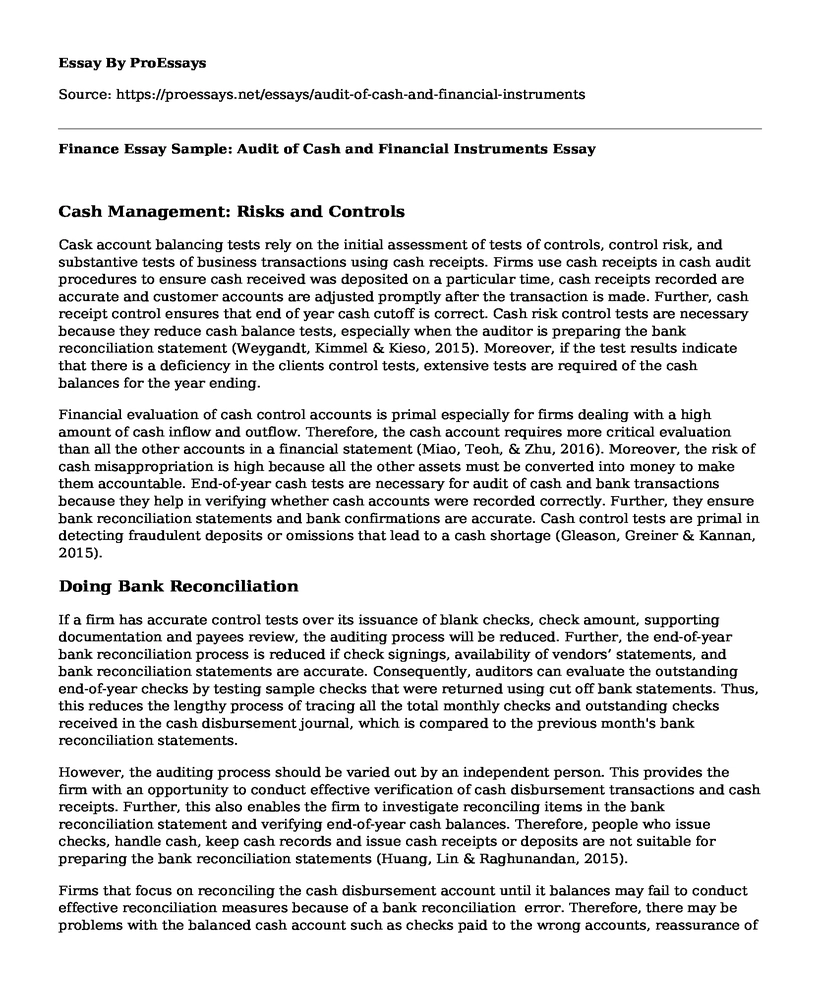Cash Management: Risks and Controls
Cask account balancing tests rely on the initial assessment of tests of controls, control risk, and substantive tests of business transactions using cash receipts. Firms use cash receipts in cash audit procedures to ensure cash received was deposited on a particular time, cash receipts recorded are accurate and customer accounts are adjusted promptly after the transaction is made. Further, cash receipt control ensures that end of year cash cutoff is correct. Cash risk control tests are necessary because they reduce cash balance tests, especially when the auditor is preparing the bank reconciliation statement (Weygandt, Kimmel & Kieso, 2015). Moreover, if the test results indicate that there is a deficiency in the clients control tests, extensive tests are required of the cash balances for the year ending.
Financial evaluation of cash control accounts is primal especially for firms dealing with a high amount of cash inflow and outflow. Therefore, the cash account requires more critical evaluation than all the other accounts in a financial statement (Miao, Teoh, & Zhu, 2016). Moreover, the risk of cash misappropriation is high because all the other assets must be converted into money to make them accountable. End-of-year cash tests are necessary for audit of cash and bank transactions because they help in verifying whether cash accounts were recorded correctly. Further, they ensure bank reconciliation statements and bank confirmations are accurate. Cash control tests are primal in detecting fraudulent deposits or omissions that lead to a cash shortage (Gleason, Greiner & Kannan, 2015).
Doing Bank Reconciliation
If a firm has accurate control tests over its issuance of blank checks, check amount, supporting documentation and payees review, the auditing process will be reduced. Further, the end-of-year bank reconciliation process is reduced if check signings, availability of vendors’ statements, and bank reconciliation statements are accurate. Consequently, auditors can evaluate the outstanding end-of-year checks by testing sample checks that were returned using cut off bank statements. Thus, this reduces the lengthy process of tracing all the total monthly checks and outstanding checks received in the cash disbursement journal, which is compared to the previous month's bank reconciliation statements.
However, the auditing process should be varied out by an independent person. This provides the firm with an opportunity to conduct effective verification of cash disbursement transactions and cash receipts. Further, this also enables the firm to investigate reconciling items in the bank reconciliation statement and verifying end-of-year cash balances. Therefore, people who issue checks, handle cash, keep cash records and issue cash receipts or deposits are not suitable for preparing the bank reconciliation statements (Huang, Lin & Raghunandan, 2015).
Firms that focus on reconciling the cash disbursement account until it balances may fail to conduct effective reconciliation measures because of a bank reconciliation error. Therefore, there may be problems with the balanced cash account such as checks paid to the wrong accounts, reassurance of checks to the wrong account, and fund kits will be unavailable when using an internal financial controller. The bank reconciliation accounting process should entail a critical examination of checks cleared with the financial statement, appropriate cash receipt tests with deposits made in due time and a follow up on previous outstanding checks.
Conclusion
Bank reconciliation statements are effective cash control tests that help firms to evaluate their financial status. Moreover, a proof of cash statement is necessary for verifying bank reconciliation statements. Proof-of-cash statements help firms to discover any disparities between the cash disbursement and the bank reconciliation statement.
References
Gleason, K. C., Greiner, A. J., & Kannan, Y. H. (2015). Auditor Pricing of Excess Cash Holdings. Journal of Accounting, Auditing & Finance, 0148558X15617396.
Huang, H. W., Lin, S., & Raghunandan, K. (2015). The Volatility of Other Comprehensive Income and Audit Fees. Accounting Horizons, 30(2), 195-210.
Miao, B., Teoh, S. H., & Zhu, Z. (2016). Limited attention, statement of cash flow disclosure, and the valuation of accruals. Review of Accounting Studies, 21(2), 473-515.
Weygandt, J. J., Kimmel, P. D., & Kieso, D. E. (2015). Financial & Managerial Accounting. John Wiley & Sons.
Cite this page
Finance Essay Sample: Audit of Cash and Financial Instruments. (2021, Mar 19). Retrieved from https://proessays.net/essays/audit-of-cash-and-financial-instruments
If you are the original author of this essay and no longer wish to have it published on the ProEssays website, please click below to request its removal:
- The Superior Capital Budgeting Methodology
- AutoZone Case
- Healthcare Services and Resources to Native Americans
- Pairs Trading Research Paper Example
- New Zealand Banker's Association (NZBA) Paper Example
- Fraud and White-Collar Crime Paper Example
- Paper Example on Comparing Capital Expenditure of Apple Inc. and Samsung







